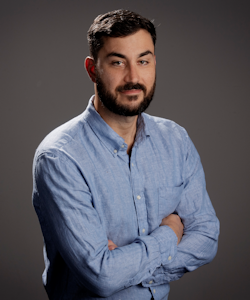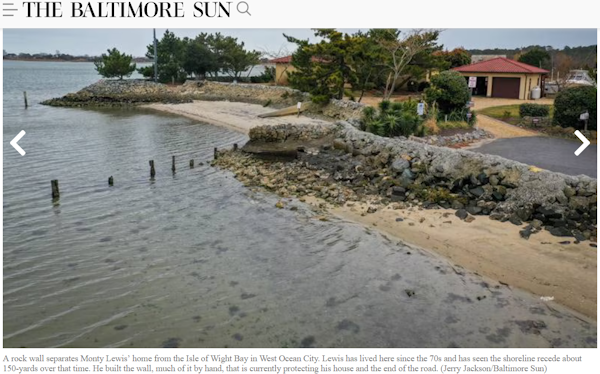SEJournal Online is the digital news magazine of the Society of Environmental Journalists. Learn more about SEJournal Online, including submission, subscription and advertising information.
 |
Inside Story: Award-Winning Beat Reporting Highlights Legacy of Environmental Racism
A series of articles on the environmental challenges in Maryland — highlighting flooding, salmon farming and Baltimore water contamination — won reporter Scott Dance first place for Outstanding Beat Reporting, Small, in the Society of Environmental Journalists’ 22nd Annual Awards for Reporting on the Environment. Judges spoke of how his sharp-eyed regional reporting explored racial inequities exacerbated by climate change and environmental neglect: “Through a mix of hard news and explanatory reporting, coupled with data analysis and on-the-ground narratives, Dance shined light on a remarkable range of issues weighing on the greater Baltimore area." SEJournal Online recently caught up by email with Dance about his work. Here is the conversation, edited lightly for clarity. For more, see a short video interview with Dance below.
SEJournal: How did you get your winning story ideas?
Scott Dance: A common thread among stories on my beat is that I consider: Who do climate change, extreme weather and pollution affect the most, and how? It may be waterfront communities where sea level rise is catching residents off guard despite years of evidence of its threat, or where their cries for help are going unheeded. Or it may be communities where environmental problems are just one of many concurrent crises. Regardless, in each case, the questions point me toward dramatic examples and, often, a need for accountability.
SEJournal: What was the biggest challenge in reporting the pieces and how did you solve that challenge?
The biggest challenge in telling
the story of a community
in crisis is earning its trust.
Dance: The biggest challenge in telling the story of a community in crisis is earning its trust. When I knocked on the doors of waterfront homes or stopped people who were waiting in line for bottled water because they couldn't drink from the tap, I had some people dismiss me right off the bat, to be sure. But in most cases, I just spoke with honesty about why I was there and what I was interested in, and then I listened to what people had to say. That usually does the trick.
SEJournal: What most surprised you about your reporting?
Dance: When I set out to explore a database of repeatedly flooded properties, I struggled to venture a guess as to how many there might be in Maryland, or what would constitute a surprising number. But the data analysis was as illuminating as it ever is: I was surprised to learn that there were 1,300 such properties, and shocked to see that flood risks had been addressed at only one in eight of them. This, to me, underscored how important data reporting is and how it can uncover news that is right under our noses.
SEJournal: How did you decide to tell these stories and why?
 |
Dance: Like any journalist, I choose the stories that I think will help people see the world in a new way. I felt it was essential to lay bare, again and again, the ways the environment affects people and the ways people harm the environment.
SEJournal: Does the issue covered in your story have disproportional impact on people of low income, or people with a particular ethnic or racial background? What efforts, if any, did you make to include perspectives of people who may feel that journalists have left them out of public conversation over the years?
Dance: As a white reporter for the paper of record in a predominantly Black city, I felt it was imperative to dedicate so much of my reporting to Black communities. To do this, I went beyond the (predominantly white) environmental groups that so often set the agenda and sought out leaders in communities of color to hear their stories. And I made every effort to reach residents of these communities directly, in some cases literally stopping them on the sidewalk to hear what they had to say.
SEJournal: What would you do differently now, if anything, in reporting or telling the story/series and why?
Dance: I would have spent more time seeking out the stories of people who are the most vulnerable and the hardest to track down. There are reasons some communities get covered far less than others, and I would have taken even more efforts to reach them.
SEJournal: What lessons have you learned from your coverage?
Dance: I learned the importance of showing readers the real-life impacts of climate change and environmental crises, which can all too often seem so abstract and be hard for some people to care about.
SEJournal: What practical advice would you give to other reporters pursuing similar stories, including any specific techniques or tools you used and could tell us more about?
Never underestimate the power
of a cold call or a door knock
to show you new things.
Dance: Never underestimate the power of a cold call or a door knock to show you new things. Take the time or seek the help to do data reporting, because it can so enrich stories and reveal things no one would have otherwise known.
SEJournal: Could you characterize the resources that went into producing your prize-winning reporting (estimated costs, i.e., legal, travel or other; or estimated hours spent by the team to produce)? Did you receive any grants or fellowships to support it?
Dance: Most stories in my entry were the product of investment in a full-time environmental reporter who was given weeks at a time to dig into a single story (with some interruptions for breaking news and shorter-term stories, of course). A story using data reporting to explore repeatedly flooded properties in Maryland came out of an Abrams Nieman Fellowship for Local Investigative Journalism, which covered my salary for nine months and also paid for travel. (Many other stories that came out of the fellowship were published in 2022.)
SEJournal: Is there anything else you would like to share about this story or environmental journalism that wasn’t captured above?
Dance: To me, the best environmental journalism artfully blends science with personal stories that bring it to life. I'm proud to have accomplished that, hopefully, with these stories.
[Editor’s Note: Read more about Dance’s reporting, and that of other prize-winning journalists in our recent Inside Story: “In Their Own Words — Story Insights From SEJ’s 2023 Award Winners.”]
Scott Dance spent a decade at The Baltimore Sun, his hometown newspaper. He reported on environmental issues for the bulk of his time there, tracking the health of the Chesapeake Bay and its flora and fauna, as well as urban ecological issues and Baltimore's legacy of environmental racism. He also covered the historic New Horizons flyby of Pluto, the arrival of Superstorm Sandy and topics ranging from astronomy to geology to health. Dance was a 2021 Abrams Nieman Fellow for Local Investigative Journalism at Harvard University. In September 2022, he joined The Washington Post's climate desk in a role covering extreme weather news and the intersections between weather, climate, society and the environment.
* From the weekly news magazine SEJournal Online, Vol. 9, No. 13. Content from each new issue of SEJournal Online is available to the public via the SEJournal Online main page. Subscribe to the e-newsletter here. And see past issues of the SEJournal archived here.













 Advertisement
Advertisement 



